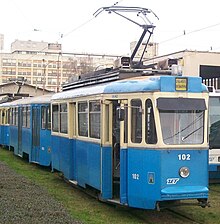TMK 101
| TMK 101 | |
|---|---|

TMK 101 in the tram depot
|
|
| In service | 1951 – 2008 |
| Manufacturer | Đuro Đaković |
| Constructed | 1951 |
| Number built | 78 (Đuro Đaković) + 3 (ZET's workshop) |
| Operator(s) | ZET Zagreb |
| Specifications | |
| Train length | 11 m (36 ft) |
| Width | 2.2 m (7 ft 3 in) |
| Doors | 3 |
| Maximum speed | 60 km/h (37 mph) |
| Weight | 14.9 t (14.7 long tons; 16.4 short tons) |
| Power output | 2×60 kW |
| Track gauge | 1,000 mm (3 ft 3 3⁄8 in) |
TMK 101 is a type of two-axle tramcar which was used in Zagreb, Croatia, from 1951 until December 2008 (last regular service). The vehicle type has now been withdrawn from regular service. Its continuous output power was 2×60 kW, passenger capacity was 95 and its maximum speed was 60 km/h. The tram 101 was the first modern type of tram produced in Croatia with automatic door openers, driver's and conductor's seats, electrical, air-operated and mechanical brakes, and with a protective shield in front of the tram.
Engineer Mandl and his team of constructors in ZET's workshops finished constructing the prototype of ZET’s new tram-101 on April 4, 1951. Three prototypes were made in ZET’s workshops; after that Đuro Đaković factory from Slavonski Brod, based on ZET’s technical data, took over the production of these types of trams. Series production began in 1957 and lasted until 1965.
A book written about this tram was called Tram 101: 1951-2008 (authors Dražen Bijelić and Željko Halambek).
This trams have also been in use in Osijek from 1963 to 1981 and in Belgrade from 1964 to 1980.
This trams have been used all three Yugoslav colour schemes, each for every town. In Zagreb have been cream-and-blue, in Osijek cream-and-red, and in Belgrade cream-and-green.
...
Wikipedia
